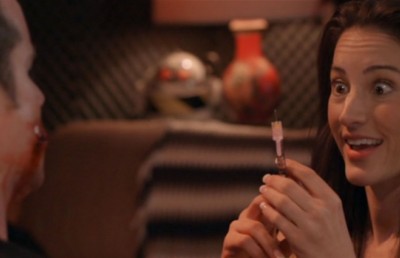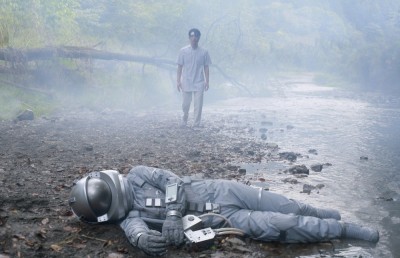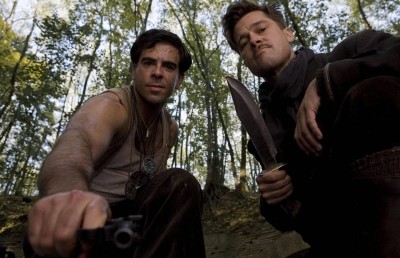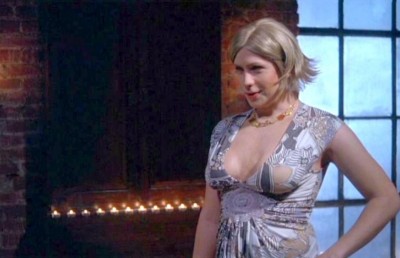Coffin Joe Returns to Montreal
An Interview with Jose Mojica Marins
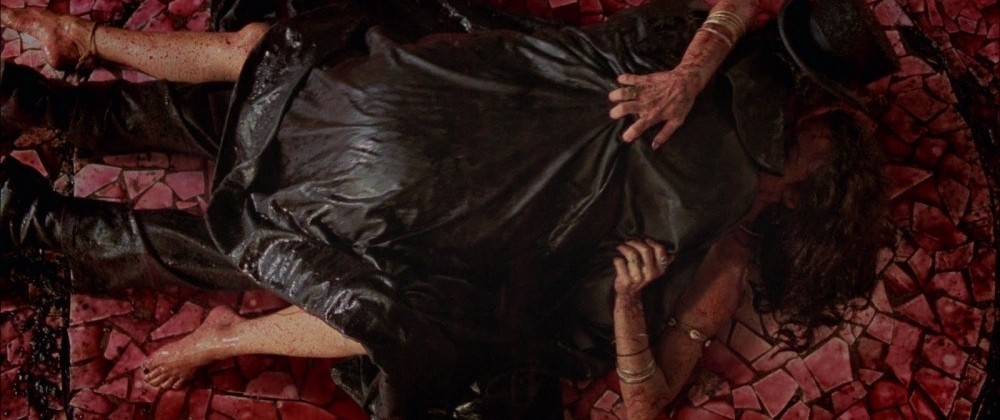
On July 25, 2009, I met with the Brazilian horror maestro Jose Mojica Marins (better known by his on stage persona Zé do Caixão, or Coffin Joe), his friend and collaborator Dennison Ramalho, himself a filmmaker of some repute, and Marins’ son, Crounel Marins, in the lobby of the hotel where they were staying at during the 2009 Fantasia International Film Festival. Both Jose Mojica Marins and Ramahlo are no strangers to Fantasia. Marins was here in 2001, for a major retrospective of his films, and granted me an interview back then. Dennison was invited to Fantasia back in 2003 to present his outstanding short film Love from Mother Only, which won short film prizes at that competition (and others), and was subsequently released on the Fantasia produced short film DVD compilation, Short Gauge Trauma. Marins returned in 2009 to present the long awaited conclusion to his Coffin Joe trilogy, Embodiment of Evil, as well as receive a Lifetime Achievement Award from Fantasia. As well as being a participant in this interview as screenplay writer for the film, Dennison served as a gracious translator for the interview.
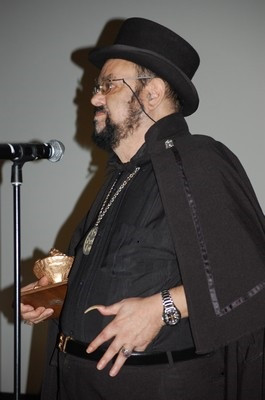
Marins receiving his Lifetime Achievement Award (designed by Rick Trembles)
Embodiment of Evil Marks a strong return to the big theatre experience for Mojica Marins. The film remains faithful to the classic high contrast Universal/Expressionist visual style of the first two films, while updating the violence and intensity to today’s levels. Marins is still in search of the perfect (to his twisted ideals) woman who will be able to bear him a male prodigy. And while he is over thirty years older than he was in the first two installments (At Midnight I Will Take Your Soul, 1964, This Night I Will Possess Your Corpse, 1967), he still projects the necessary sense of menace and demi-god-like powers into the Coffin Joe character. Read on, but you have been forewarned of the hypnotic powers of Coffin Joe.
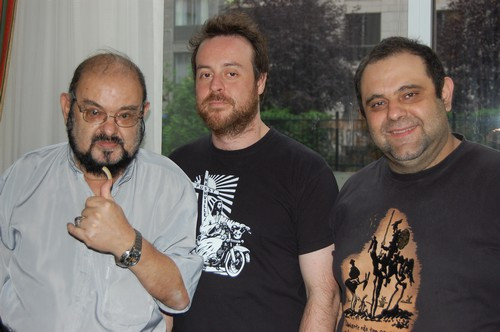
(l-r) Jose Mojica Marins, Dennison Ramahlo, Crounel Marins (son)
Offscreen: Dennison, how did you get involved in this project?
Dennison Ramahlo: I always wanted to be involved in the creative process with Mojica. I am a disciple. He is my intellectual mentor, my film mentor. In other interviews I have said that in films he is my father. He gave me an orientation in my artistic pursuits. I was always around, even when I lived in a city far away from Sao Paolo, I would go to Sao Paolo to hang around at his studio and hunt down his films. So it has been a 14 year friendship. Mojica’s opinion and guidance have been influential in my own film work, especially my first short, Noturna, for which he gave me great ideas that helped change the ending, and I’ve dedicated it to him. I moved to Sao Paolo after this first short and was working as an assistant director to Paulo Sacramento, who is the producer and editor of Embodiment of Evil. Paulo is a great guy and great friend of both of us. He is a young talented filmmaker, a director, who to this day has been more into documentary films. He won a best documentary award in 2002 at Tribeca for a prison documentary called the Prisoner of the Iron Bars (2004). And while I was working with him on this prison doc he came up with the idea of trying to get Mojica to make the third Coffin Joe film. At the time he was producing a film called Mango Yellow (2002) a film made by a director from the Brazilian Northeast named Cláudio Assis. He was gaining producing experience and wanted to use that to help Mojica, who he saw as person with the best horror ideas. He told me that he has always been involved with strong, harrowing, transgressive films, and wanted to take advantage of this to help Mojica get his projects on its feet. Both of us knew that Mojica had an old film stashed that he couldn’t get in gear. It was Embodiment of Evil. Brazilian critic Jairo Ferreira made a documentary that played at the Brasilia Film Festival, one of the most important festivals in Brazil, in 1978 called Horror Palace Hotel. Back then Mojica was talking of making the third installment of the Coffin Joe trilogy. It is an idea that dates back to the late 1960s. He had many producers along the way. Two of them died! All of a sudden the film was stuck. No one had brought it back from the ashes. Jairo, a good friend of ours, who died in 2003, encouraged us. It was a dedication to the lifetime work of Mojica. But we also thought this film was a project owed to Brazilian cinema and Brazilian cinema owed it to him. We went up to Mojica and asked him if he had any projects he wanted to get done, and he said Embodiment of Evil. That was in 2001 and we spent over 6 years trying to raise public funds. I was not involved in the financial aspects, but was always around, was informed about its development. Over three years we were discredited by the jury of the grant agencies. So it took a certain broad minded jury to give us our first bit of money and we also got a subsidy from the Sao Paolo state government. Coupled with this and that, and the Fox pre-distribution deal, and the company Cinemark, we came up with an amalgam of money that made the movie feasible. This eventually led to two other producers becoming involved, brothers on Fabiano and Caio Gullane. The efforts of myself, Mojica and Paulo resulted in the first level of funding. And then more experienced producers ended up getting all the rest of the money to make the film.
Offscreen: I noticed that the main actress from your amazing short film Love from Mother Only, Débora Muniz (as Formosa) is in this film. I was hoping her role would be bigger because she was so good in Mother Only. Had Mr. Marins seen your short film, and was that how she was cast?
Dennison Ramahlo: It is the opposite. Mojica will answer this question.
Jose Mojica Marins: Debora is a pupil. She started working with me when she was 14. I discovered her. We have this big amusement park in Sao Paolo called the Play Center, which is where Embodiment of Evil ends. In the late 1970s, early 1980s Play Center would twice a year promote this horror night, called Night of The Terror, and I would be involved as creative director in the staging of the whole project. He would get the actors, the costumes, the makeup, to scare people in between the rides. It was an interesting entertainment option for over 25 years. It is still around but I am not involved anymore, but I helped create it. Debora was one of the main actresses involved in the Night of the Terror. In one year she played a witch that was burnt at the stake at the end of the night. Everyone would gather around to watch this event. She almost got burned. This was the early 1980s. So to this day I have a cordial relationship with her.
Dennison Ramahlo: She is one of my best friends but Mojica sees her more than I do. She is often at his house. It is like family.
Jose Mojica Marins: She is extraordinary both in Dennison’s short and my feature.
Offscreen: In terms of trilogies, we can talk about someone like Dario Argento, who also recently made a long awaited final film to a trilogy of about 30 years, but his fans were disappointed because he made something very different from what fans were expecting. Compared to Argento’s long-awaited end to his trilogy (Suspiria, 1977, Inferno, 1980, Mother of Tears, 2007), your third film is very much like the first two films in many respects, and is much closer in spirit and plot to the first two films, with some new added elements. So my question is, how did you balance making something which respects the heritage of the trilogy but also tries to make something different and bring it a different direction? If you have seen Mother of Tears most fans say it is horrible…..but with this film it is definitely a continuation. Did you think about this heritage but add something different so it would be interesting for you?
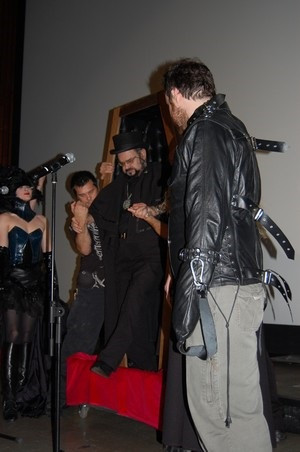
Marins Arriving on the Fantasia Stage Via Coffin
Jose Mojica Marins: As for the balance of the best elements and traits of the Coffin Joe character in a contemporary construction, this is a character with a predefined agenda. He has this obsession of finding this perfect woman to spawn the perfect child. This didn’t change. The essence of the character and his ideas remains the same. There is also the three dimensionality of the character, in that he is a villain but has this love of children, while still being very much the villain. He is still someone who can commit these heinous acts but can still have affection for children. These traits strongly protected during the making of the film so that they relate strongly to the past and the two films. I had a rigorous observation of the dogmas involved with the character and in the interweaving of this third film as a component of the first two. On the other hand, as a response of the world Mojica faces today as a filmmaker over twenty years later, likewise Coffin Joe as well finds a new world, and living in prison, he finds a world in which he faces urban violence, the expansion of drug abuse, impersonality and cruelty. So Coffin Joe delivers an adaptation and a response to this world in terms of a defense of his ideas and the means to achieve them. He defends them as the world he finds requires him to do so. So if he finds a violent world, he is way more violent. As in the previous films, if I came up with Embodiment of Evil as it was made today I would never have been able to release the film in the 1960s. It was not a film suitable to that day and age. So I sense that I am delivering a film that is at the height of a response to the world we are living in today both fictionally, that is in terms of content, and non-fictionally, meaning the way it is made to relate to the world today. With respect to the image concept and the technical way of making it now, which was different to the way I used to work in the 1960s, it is also a demand of what is happening cinematically in the movies today. I am not contaminated by some fad, or some technical necessity. It is just the way films are made today. I got the best I could get for my films today, relative to what I achieved in the 1960s. One thing I really did emphasize, is that all these enormous levels of violence and catharsis and sexuality in the film is not my response to the torture porn fad, or the type of films that are made today, here or in Japan. No this is just the kind of film I always wanted to make. As time evolved, I evolved and this is the film I delivered for this day and age.
Offscreen: What you have said reminds me of Time after Time (Nicholas Meyers, 1979), the H.G. Wells adaptation, and the moment where the Jack the Ripper character (played by David Warner) is propelled by time machine from Victorian England into the future of 1979, and he sees on his hotel television all the violence in the world, the horrors of war, crime, poverty, etc., which sort of make his crimes pale in comparison. He says “I am an amateur compared to these guys.” The Coffin Joe character is also taken aback by the levels of violence he sees, but the difference here is that he goes still further than them.
Dennison Ramahlo: Yes, he adapts to be more violent!
Offscreen: One of the ways this film connects with the first two is the fact that you have many different characters. You have the crazy priest whose son was the doctor who was killed, the ghosts that come back, but you also stock footage from the previous films as well. Was it a problem getting the rights to use the footage of your own films? Second question relates to the way the ending was changed in the original version of This Night I Will Possess Your Corpse, because Coffin Joe consents to God and it was done in voice-over with his head turned from the camera. We hear him say, “I believe in God, God is the truth. I believe in your force,” but it was not supposed to end like that. I love the way it is recreated in Embodiment of Evil, with the actor who is the Marins look alike. I am curious to know how close the ending in Embodiment of Evil is to the ending you wanted back in the original film in 1967, but that was presumably never shot?
Jose Mojica Marins: I did not have the rights to my own films, but when Embodiment of Evil was really gearing up and we really wanted to use the original footage, I bought them from the holder, the other 50% I did not own. But it was a tough negotiation and I suffered a lot. And when I did the negotiation, I never mentioned that the third film was being planned because otherwise the demand would have sky rocketed the asking price!
Offscreen: He gets shot in the second film.
Jose Mojica Marins: Yes. In the original second version he is wounded. He relentlessly blasphemes against God, and he makes violent advances at the villagers, but he is physically overwhelmed, detained and ends up going crazy by his own delusions. In the original ending for This Night I Will Possess Your Corpses, he ends up being detained in an asylum. This was the original ending where he does not give in to God or religion. I had a commitment to the new film being made and not exactly to the old project. So I had the original intent of Coffin Joe, of standing up to for his philosophy whatever the consequences, but thought it could be weaved better into the story if we had the denial of Christ, coupled with the murdering of the priest, the piercing of the police man’s eye, who would come back as a ghost to hunt him down, all tied in to make the story of Embodiment of Evil stronger. But I think the intent of Embodiment of Evil was achieved in the sense that Coffin Joe finally stands up to what the censors didn’t want by being able to do this, so I feel avenged; but on the other hand, it expresses and ties in to the structure of Embodiment of Evil to make it work as a separate piece.
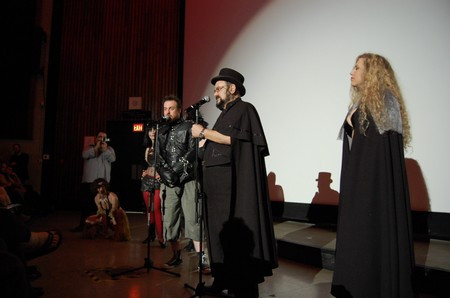
Marins on Fantasia Stage
Offscreen: What is interesting, and I don’t know if it was intentional on your part, as a memory thing, but when I saw Embodiment of Evil – and I know the first two films very well– because of the way the new footage is integrated so well, with the Marins look-alike actor, even the actor who plays the priest looked like the priest in the 1967 film, the way the reconstructed footage is made to look similar to the original, I had to go back to watch the original footage to make sure that the new footage wasn’t stock footage! So was part of your intent to make people confused into thinking that maybe they were watching the original? In any case, it is to your creative credit that you make them match so well!
Jose Mojica Marins: The cinematography was well studied to match the look of the previous film but we also took care to match the sound as well. The sound, the black and white, we made a more lo-fi, muffled sound to match the original. It was a very rigorous task, where we had to study the film very hard. Luckily our Director of Photography (DP), José Roberto Eliezer, was an experienced guy.
Offscreen: The actor playing the young Zé do Caixão at the end of Embodiment of Evil, Raymond Castile, looks remarkably like Marins. I heard he was cast through youtube. Can you talk about how he was cast? And is he Brazilian?
Dennison Ramahlo: No he is American.
Offscreen: What is the story behind that!
Dennison Ramahlo: Raymond Castile. This is one of the most fascinating stories in the whole production.
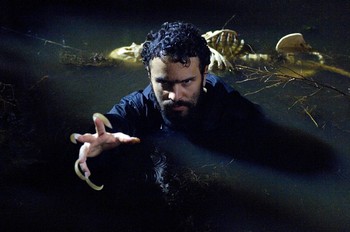
Raymond Castile as the ‘young’ Marins
Offscreen: I thought it might be, which is why I asked it!
Dennison Ramahlo: I will answer this because I know the history very well. As you may guess, Mojica is regularly in the papers in Brazil. Because he is very involved in cultural activities in Sao Paolo, as he is usually giving a lecture, a performance, appearing at an event, or attending a retro of his films. So he once saw a picture of himself as a younger man, that someone had cut and pasted from a press release, saying that he was going to be somewhere at an event, but Mojica did not remember taking that picture. He looked at the medallion, and he knew it wasn’t his. So he knew it must have been someone dressed up like him. So he got someone to Google around for his images and he came across Raymond’s website. Raymond is from St. Louis, Missouri, and he would dress up seamlessly as Mojica, with the identical costumes. He would dress up for Halloween, and perform Coffin Joe sketches, doing lines from the films, trying to speak Portuguese. He is in love with horror films, particularly Mojica’s films, and is very involved with the convention scene, horror, comics, collectibles, etc., in Missouri. So we found him through his website. I handled this part. I called him and told him we had been searching for a look-alike for two months, and with production nearing I told him very frankly that, heck I don’t know you and you don’t know me, but I have to tell you there is no one who looks as much as Coffin Joe as you do. So I asked him if he would be interested in coming to Brazil to portray your hero on screen. At first he was very suspicious. Just think of that film Rock Star (2001), with Mark Wahlberg, who plays this guy who is invited to be the singer of Judas Priest, who was a fan all his life. It was the same with Raymond. He did a whole investigation to see if this was a legitimate project. And once he found out it was a real production and we invited him he came to see us. [Mojica Marins interjects here to tell us that Raymond was the exact same age as he was back when he made that scene in 1967!] I (Dennison) told him “Cool, we saw your performances on youtube, we love it, but we don’t have any money to bring you to Brazil. So you have to pay your own way because we are on a very limited budget. So take your time and think about it.” But he did come. And he came twice, he came for the premiere too. He was amazing. I will tell you an anecdote about Mario Lima, a long time collaborator of Mojica’s, who has been in all his films, including Embodiment of Evil. He is old now, with memory problems, and he is not very lucid. Mario was walking through the studio one day and walked into Raymond and had this weird reaction because he thought it was Mojica from the past! He actually had a memory lapse. He came to speak Mojica about how he was so taken aback because the similarity between them is so striking.
Offscreen: There is a similar story here in Montreal, not sure if you know the story, about a local actor, Jean E. Guerin, who played the part of a young Orson Welles in Peter Jackson’s Heavenly Creatures. He was cast simply for his similarity to Welles.
Offscreen: I have a quote here from the first interview we did in 2001: “Before I die, my dream is to make a film where I will not need to beg my friends to help me out. I do not want to ask my technicians and cast to reduce their fees. I want to produce a film with enough money to pay my crew decently. I want to pay my crew what they deserve. That is my dream before I die.” Has the dream been met?
Jose Mojica Marins: Yes!
Offscreen: Another quote from the same interview. “I am a man of improvisation. There is no script for me. I read the script and keep it in my mind” Was this the case with this film too?
Jose Mojica Marins: Of course this time around there was more of a requirement to follow the script, not because of the size of the film or the change of context but because we had difficult experiences during production, so as much as I like improvisation I could not take unaffordable risks. So this time I had to be focused on more of a program. [Dennison interjects] But it was cool because I was at the helm of the script and he felt that we had a good connection, and therefore the changes that would be applied were minimal, respecting the character. [Back to Marins] The improvisation continued, and the script following was held to a minimum to aid spontaneity, and I was trusting of what was coming from the suggestions of the script. The script was adapted from improvisation basically. We knew what was coming.
Offscreen: This is a silly question. But in your earlier films there is this back story about how you use real animals. How the roaches and the rats we see crawling over the female characters were all real. And in this film you have tarantulas going over your own face too. So were the animals real in this film –I’m sure they were– and if so why did you have the tarantulas walking over your face. Was it a way of saying, “Ok I can do it too!”
Jose Mojica Marins: For the third film it was my option to interact with the animals, the spiders. The press dating back to my first films would always say that I was sadistic both as a character and director because I would be abusive with the women, torturing them by having animals crawling all over them; but what the press would never say is that during the creative process of the rehearsal, I would always submit myself first to the animals in order to both encourage and comfort the actors. This was never mentioned. So factoring in my interaction with the actors, it was not a novelty for me as an actor in Embodiment of Evil to have real animals crawling over me. The fact that I did it in front of the camera just clears up that I do it to myself as well, I undergo the ordeal with the actors too. It just reinforces this fact.
Offscreen: Another production history question. I heard that the actor Jece Valadão (who plays Captain Claudiomiro Pontes, Miro for short) died during shooting. How did that affect the script? [At this point Jose Mojica Marins motions that he is skipping out for a smoke, confident that Dennison knows everything about this question and can respond]
Dennison: Yes, radically. I can answer this first and then Mojica might add something. There was a recurrent archetype, although I‘m not sure that is the best word to describe it, but there was a certain type of character that Jece performed so many times in Brazilian cinema that he became typecast for this type of character, a character type that Brazilians call “Cafacesiao’ which literally translates to “the scoundrel, the trickster.” So he would always play this type of streetwise playboy, seductive with the women, but who can also be brutal with women. He played this character, with many names, in many different films. He became a landmark of Brazilian cinema. He was also a director and producer of Brazilian cinema. When we came up with the idea of Coffin Joe and this actor Jece Valadão as his rival I remember the response from local horror people, who said, “Wow this is great, this is better than Marvel vs. DC comics!” So we knew we were going in the correct way. We didn’t know that his health was going bad. He was a hulk of a man, very tall, very strong, despite his advanced age, and it was a surprise to us when he did not show up on set and found out he was in intensive care. He caught a very strong pneumonia overnight. It was unexpected. We thought he would make it and win over the sickness and come back to the film, but a few days later he went into a coma, and had a heart attack during the coma. So a red alert was installed in the production because of the coming crisis. Unfortunately he died and we were very saddened. We stopped production for a day. During the day we stopped production and we were mourning him, we held a meeting, myself, and the producers. Mojica was not there because he was very affected by his death. During the meeting we had mixed feelings about what to do next. What I wanted to do was protect my screenplay, and I thought it would be insane to try and change the story at this point in the production. I thought let’s hire another actor and re-shoot the scenes we did with Valadão. We were so afraid of what could happen. On the other hand, we knew this would be an important film for Brazilian cinema if it becomes known as Valadão’s last film. Ending his career with a Mojica film would be a very important fact in Brazilian cinema. This is the perception Mojica had. From the day Jece died Mojica said, “Valadão stays in the film.” We are going to rewrite the story. On the day Valadão died it was very difficult for me because the whole crew gathered, people were crying, Mojica was crying very much. Mojica gave a small speech to the crew and said Jece will stay in the film and I trust Dennison’s ability as a screenwriter to find a way to go around this problem and keep Jece in the film. When Mojica said that it felt like a tree trunk being rammed into my ass! Man I am fucked! I was terrified for days. But looking back now I think it was a wise decision because it was a great pride for us to have Valadão’s career end with our film. It would arouse the interest in viewers to come out and see Valadão for the last time in such a weird film.
Offscreen: How about when his head is cut, was that written before or after he died?
Dennison Ramahlo: In the previous version of the script, where Valadão plays the character from the beginning to the end, there is an early raid at the Favela where the kids are killed and Coffin Joe gets to witness this murder of the kids. Coffin Joe confronts the policeman, captain Oswaldo who is the brother of the character played by Valadão, captain Miro. The actor who portrays captain Oswaldo is Walter Stewart. So in the original version of the script Coffin Joe confronts Miro’s brother. That scene was shot after Valadão died, but it was originally intended that Miro would have his eye pierced in a very extreme close-up. We had the prosthetic of Valadão’s head ready so we could shoot a very realistic shot of Coffin Joe’s needle going into Captain Miro’s eyes, but Valadão died before we shot that scene. But still our Special Effects man had the clay mold of Valadão’s head, so he managed to sculpt a perfect head for Miro (Valadão). This was an idea I had to fiercely defend because in the beginning the producers were lazy, they said, oh Coffin Joe could just pop out from behind a tree at the chase scene and just shoot Miro him from behind. The character’s destiny is sealed. And I said, no way, first off Coffin Joe would never kill someone with a gun, and the destiny of such a great actor as Valadão could not end in that way, shot like some chicken. You have to have a dramatic, gruesome scene, so I came up with that scene since the mold was available. I know from my experience with effects that we could sculpt a head from that mold. The head is now with me. It is in my personal archives of props.
Offscreen: I noticed in this film and I can’t remember if it was in his earlier films, but here there is the constant use of the slide wipes. Was that an illusion to comic books?
Dennison Ramahlo: Totally. We knew from the beginning that there would be weird transitions because that is something that Mojica has used in the past. And we thought it would be cool to use them because you rarely see them today. I was away during the editing, working on other projects. Paolo Sacramento took the decision of using these strange wipes. And there is this one shot where the priest listens a radio news about the return of Coffin Joe, and it ends up with a spinning shot of the radio. This l dates back to the fad of Mojica’s time of the 1960s. We thought it would be cool to revisit these transitions [Mojica returns from his smoke].
Offscreen: I really appreciate the way the film maintains the visual quality of Giorgio Attili’s chiaroscuro cinematography from the first two films, whose work I thought was really remarkable. Two of my favorite moments in Embodiment of Evil make use of this type of lighting, one is the intro of his character when he emerges from the shadows as a silhouetted bat figure, and walks toward the foreground. It is interesting with Coffin Joe an evil character, to see him coming from the darkness into the light; you would think of him as a character who is always in the dark; and then later on there is the great scene where the priest is running away. You think Coffin Joe is dead but then you see his shadow chasing the priest. That is one of the best shots in the film.
Dennsion Ramahlo: You like that! That’s me! I am the shadow, yes.
Offscreen: When observant people point to the two first films they usually note the chiaroscuro lighting and the references to the gothic and the Universal horror films, and that is still there in this film, something which is not in a lot of other contemporary horror films. So was that a conscious homage to the work of Attili, an attempt to carry on that tradition of chiaroscuro lighting?
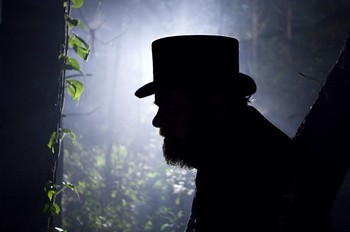
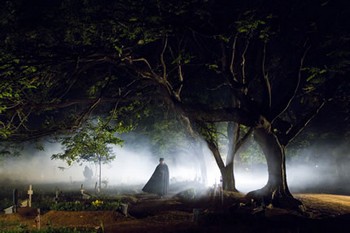
Classic Horror film Lighting from Embodiment of Evil
Jose Mojica Marins: The first think that needs to be said, is that our DP, José Roberto Eliezer, who we’ve nicknamed Ze Bob, tried to emulate the style of Attili by contextualizing it with his own style. From the beginning it was a very sharp orientation from to Ze Bob: to study Atilli’s style. José already did that way before he was even invited to make the film because he was a big fan of Giorgio Atilli as well.
Offscreen: I can see that because, for example, the chasing shadows, is a very specific Expressionistic device.
Jose Mojica Marins: Yes, this comes directly from my heritage with Atilli. And this more classic kind of horror look, the chiaroscuro and the play with shadows.
Offscreen: It is nice to mix that style with a more contemporary look. This might just be the way I saw a couple of scenes, but some of the torture scenes, with the sense of hysteria in them, with Bruno’s (Rui Rezende) sadistic glee, reminded me of the torture scenes in The Texas Chainsaw Massacre. I wonder whether you have seen that film, because it was in the earlier films, at least not with that level of hysteria, especially with the abrasive sound effects.
Dennison Ramahlo: I see. I know the film very well of course, the original.
Offscreen: The scenes at the end.
Dennison: And the scenes where the hitchhiker is jumping around and yelling.
Jose Mojica Marins: I’ve never seen the film, though I know it by name.
Dennsion: I can see the resemblances and the analogy is adequate, but on the other hand in Embodiment of Evil it is a group torture scene with many people involved. We shot many options so Paolo could combine the scene well. But I think it was more a coincidence because the editor, Paolo Sacramento, is not a horror fan per se, not like Mojica and I am because I am an avid fan. I remember the scene well in The Texas Chainsaw Massacre and I can see the similarities, but our scenes even have a different approach because the characters are so stylized, the costumes, in their characterization as horror villains from another day and age. I think it has its distance, and there are shots that are similar, with the extreme close-ups of the girl trying to escape her capturers.
Jose Mojica Marins: With me it often works the other way around. For example, people used to compare me to Bunuel, and I had never seen a film by Bunuel in the 1960s. Only after people made these comparisons did I go see the films, so it will be the same thing with The Texas Chainsaw Massacre, I may go see it now. The only two films that were really influential to me are Poltergeist and Rosemary’s Baby. These are the only two films that I really consider as general influences on my work.
Offscreen: I like the ending. You have this possibility that Coffin Joe is looking for an offspring and he gets seven women pregnant! There are so many possibilities for sequels with seven little Coffin Joe’s running around. I find it interesting that the film has been successful in Brazil and garnered critical respect [Embodiment of Evil won 7 of 15 categories at last year’s Paulinia Film Festival in Brazil including best film, the critics’ choice award, best photography (José Roberto Eliezer), best film editing (Paulo Sacramento), best sound editing (Ricardo Reis), best soundtrack (André Abujamra and Márcio Nigro), and best art direction (Cássio Amarante).] Plus the fact that it has not suffered any censorship. How can you explain this change with respect the lack of censorship? Is it a result of the new President, Luiz da Silva, is he more open to the arts?
Jose Mojica Marins: Yes definitely. We are living in another context now, very different from the censorship I had to endure in the past.
Offscreen: Are you surprised at the many prizes it won? In terms of the Paulinia Film Festival?
Dennison: That is where we premiered.
Jose Mojica Marins: That is one we were sort of expecting. It is a big festival in Brazil.
Offscreen: Normally when this happens in Hollywood it leads to a spin-off effect with scripts, funding, coming your way. Will this happen with you?
Jose Mojica Marins: There are always proposals and projects both personal ones and other prospective producers for projects. Now that I am ending this tour with the film I will have more time to dedicate to other projects. But I have lost four projects this year and maybe it is because I don’t have an agent and I have to rely on non-professional people, my sister, my son Crounel, to help me evaluate projects. Even with all their good will, and Crounel has many professional attributes, and my sister is a filmmaker, even with all the goodwill my family provides I would need someone as a full-time agent. But I am optimistic that I will have more focus and dedication to future projects.
Offscreen: Do you have any DVD distribution deals in place for the film?
Crounel Marins: There is an upcoming DVD release in the UK and in Germany. Fox had a priority for Latin America and North America, they had one for Europe but recently they waved the European territories and the sales agent Horizon took over. They are the ones trying to come up with DVD deal release.
Offscreen: Is that for Blu-Ray too?
Dennison: I heard that there will be a Blu-Ray for the UK market. As for other markets, France has always embraced and received Mojica’s films really well but there is not sign yet of a DVD release there. And nothing for North America yet either. Crounel says he will soon have a report from the producers to update him on these matters because everyone wants to know this.
Offscreen: It should get a major DVD release, especially in North America. The fans want it and it would do quite well I’m sure.
Offscreen: There’s a Mojica quote where he says, “Every horror film should have beautiful women and ugly men.” Now I don’t think that is right because Marins is an attractive man [which brings a big laugh out of Dennison]. But it sounds like a well known Argento quote, who said: “I like women, especially beautiful ones. If they have a good face and a good figure, I would much prefer to watch them being murdered than an ugly girl.” What this tells is that there is this aestheticization that we have with violence, and Argento is an interesting director because he does that, he really aestheticizes his murders; you don’t see it as violence but as art. Is that something that you can say about your film, because it has these wonderful set-pieces. Is that what you meant with that quote about “beautiful women and ugly men, ” that the aesthetic is more important and since women in art have been traditionally used to represent beauty – the beautiful creatures– and that men are just men?
Jose Mojica Marins: What it provides is a contrast, an ugly man killing a beautiful woman accentuates this contrast. If it is a beautiful man dying no one cares, but a beautiful woman gets everyone all excited. This is important that beautiful women should be the victims.
Offscreen: Edgar Allen Poe said that the most tragic thing is the death of a beautiful young woman. So you can also add this sense of tragedy.
Jose Mojica Marins: It brings a tear to your eye, you feel it more. Because all the perverts and sadistic viewers will get aroused!
Offscreen: But what is interesting in your films is that the only time you have characters that share Coffin Joe’s world view, it is women. You have the doctor Hilda in this film, the Laura character in This Night I Will Possess Your Corpse You never have men.
Dennison: Well there is the hunchback, the acolyte.
Offscreen: Yes but they do not profess, like the women do, who give themselves up to his philosophy.
Jose Mojica Marins: For sure Coffin Joe is seductive to the point of near hypnosis.
Offscreen: Ah yes, his eyes!
Jose Mojica Marins: Women like powerful men. And Zé do Caixão is a very powerful man, his presence. I would like very much to be Coffin Joe, and to have all the girls he has had!
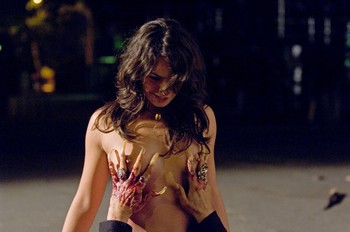
The seductive powers of Coffin Joe
Offscreen: In the first two films if I remember correctly, it is only the Zé do Caixão character who does the really bad things. But in this film you have the officers who are doing these terrible things as well. The captain who beats up his wife. The vengeful, hysterical priest Eugenio. Which I guess reflects a difference, as does going from the small town to the big city.
Dennison: Well, more than this. I can say a few things in this regard.
Jose Mojica Marins: The world has changed. Sons are having intercourse with their mothers, fathers with their daughters, there is too much violence around. So those are new characters. A reflection of the perverse modernity that we live in.
Crounel Marins: Remember that scene with the drugs.
Jose Mojica Marins: Some fans who are very beautiful women have told me that if a man like Coffin Joe existed in reality they would dump their boyfriends and wives to be with him!
Offscreen: That is interesting because there is this idea that we need the Coffin Joe character because he is so anti-law, anti-authoritarianism, and there is this irony in both the second and third films it is the law that sets him free again. In the second he is acquitted and in the third he is released by the wife of the captain. So it is almost like they put him in jail but then realize this desire they have for him, what he represents, and they let him back out, to create this cycle.
Dennison: Why would they need him?
Offscreen: Because he represents this powerful seductive figure.
Dennison: Let me see if I have your argument right. In the first film he is acquitted, but by the jury, not the law.
Offscreen: But it represents the law, the law that should be putting him away but they put him away and then release him. It is the idea that they kind of need to have this figure out there to represent seduction, power. Or maybe it is the hypnotism he has over the world. Or maybe he is the Nietzschean character beyond the law, he can’t be contained by the law.
Dennison Ramalho: Well that is what Rick Trembles wrote in his Motion Picture Purgatory of the film. He is lower than Satan and higher than God.
Offscreen: Maybe it is just a kind of irony that works on its own. In a lot of other cases the monster escapes or someone would come and rescue the monster. But Coffin Joe is let out freely. So I think there is something about that.
Jose Mojica Marins: Crounel has mentioned some important information that relates to what we are talking about. Brazilian law prevents any prisoner from remaining in jail for more than thirty years. If you get a life sentence, and this is symbolic, you will serve thirty years and be released.
Offscreen: So you had to wait thirty years for the third film!
Dennison: You have serial killers with sentences of 200 years but after thirty years they are out.
Offscreen: Can’t you give a series of thirty year sentences?
Crounel: Yes, but not more than thirty years in total.
Dennison: There is a famous story in Brazil about a serial killer, a cannibal, in the 1940s, who was released in the 1970s in Brazil. They called him Francisco the Slasher. He was released after the thirty year sentence because the Brazilian law prevents a prisoner being detained for more than thirty years. And he said, if you release me I will do it again. He said it many times. They let him out and he killed again.
Jose Mojica Marins. And I interviewed him right before he was released and he told me the same thing.
Offscreen: Was he caught and put back in jail?
Dennison: Yes. He died in jail.
Offscreen: That is a tragic story.
Dennsion: Yes, but this is a component of the film. When the director of the prison says, “fuck the law, fuck the law, we can’t release this man,” it is because of this law.
Crounel. The same system that arrested me, is now releasing me.
Offscreen: Well I’ll release you guys now and thank you so much for your time.
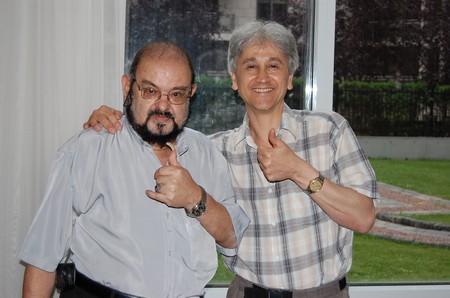
Author with Marins



